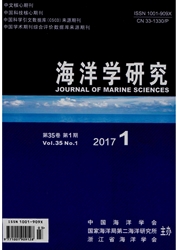

 中文摘要:
中文摘要:
本文利用ERA-Interim资料集、HYCOM全球再分析资料以及沿海各站点数据,通过分析比较2005、2011和2012年福建沿海春季(3—5月)气温、水温、风场、流场和降雨数据,探讨了2012年春季水文、气象要素的年际变化特征及其与米氏凯伦藻暴发的关系。结果表明:2012年春季暴发的大规模米氏凯伦藻赤潮极可能与初春水温偏低,晚春水温偏高,后期海水迅速升温有关:初春(3月)沿海水温偏低,抑制了东海原甲藻的前期孕育;晚春(5月)水温偏高,有利于各种藻类,特别是偏暖暴发的米氏凯伦藻的生长;3—5月海水过快的升温过程,使得米氏凯伦藻成为优势藻种。相对于气候态平均而言,2012年5月呈强北风特性,水体向岸堆积作用明显,有利于藻类在近岸的堆积聚集和种群密度的提高,为藻类的生长提供了稳定的动力环境,促进了赤潮的暴发。此外,2012年1—4月的大降雨量可能为米氏凯伦藻的生长提供了良好的生物化学环境。
 英文摘要:
英文摘要:
The relationship between the inter-annual variation of hydrological and meteorological factors and the Karenia mikimotoi bloom was analyzed using air temperature,SST(sea surface temperature),wind field and rainfall data from ERA-Interim Dataset,HYCOM+NCODA Global Reanalysis and the stations along Fujian coast in the spring(March to May)of 2005,2011 and 2012.The results show that decrease of SST in March,increase of SST in May and the higher heating rate may be the main causative factor of Karenia mikimotoibloom in Fujian coast in 2012.The relatively stronger northerly wind in May formed a stable dynamic environment by gathering the algae onshore,which promoted the Karenia mikimotoi bloom.More rainfall from January to April might provide a well biological and chemical environment for the growth of Karenia mikimotoi by offering a wealth of nutrients and microelements.
 同期刊论文项目
同期刊论文项目
 同项目期刊论文
同项目期刊论文
 期刊信息
期刊信息
